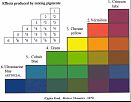|
PRIME: THE
CONTRIBUTION OF ARTISTS, continued

 Rood's Chromatics
Rood's Chromatics |
|
While
Eugene Chevruel, director of the Gobelins Tapestry
Works, worked out the law of simultaneous
contrast,
such theories were consulted intuitively, more than
scientifically by the Impressionists. Apparently,
Pissarro only read Chevruel and the work of the
American theorist, Ogden Rood that included his
table of modern
chromatics.
|
At
the age of 20, Georges Seurat was working on a precise
application of colour laws to painting. In 1886, he
showed his " Sunday afternoon on the Ile de le Grande
Jatte ", a large frieze like painting, which first
demonstrated the application of pointillism. Pissarro
tightened up the method, by precisely calculating the
number of dots necessary to produce the required hue when
seen from a distance. Seurat used Ogden Rood‘s theory
of harmonious " triads " of colours, when painting,
" The Bathers " (1883-4).
The
illustration above, provided a scale of hues mixed
from six pigments available at the time; other tables
designated the hues produced by mixtures of differently
coloured lights. Rood also noted that complimentary
colours when side-by-side, together appeared to
reflect "white light", a device later used by painters
of psychedelics. |
|

Lines of complementary colours |
|
|
|